Over the centuries many parallels have been drawn between women and the earth, starting with the age-old (and, for some, contested) Mother Earth, or Pachamama. More recently, the destruction of the earth for natural resource extraction has been compared with and attributed to the same underlying patriarchal forces as violence against women. Correspondingly, research has shown that environmentalism is perceived as un-masculine (Brough et al. 2016) and even that men are less likely to recycle than women because they are worried people will think they’re homosexual.
There is another parallel that deserves attention, but, due to its very nature, receives little – that of invisibility. Both women and ecosystems are often invisible in the same ways. Ironically, both are also omnipresent and so crucial. Omnipresent but invisible. Invisibility has dire consequences for the health of both women and ecosystems. This blog explores the ways that the perpetuation of this invisibility is structurally built into our institutions, societies and systems with a specific focus on consequences for Amazonian Indigenous women.
Women’s Invisibility
It will come as no surprise to readers to state that women are underrepresented in many spheres: politics, business, STEM (science, technology, engineering and math). Manuela Lavinas Picq’s (2014) in depth analysis of gender in Ecuadorian Indigenous politics points out that despite a discourse that advocates social justice and despite women’s prominence in indigenous struggles, Ecuador’s contemporary, Indigenous movement counts few women in its political leadership ranks.
Strong, female, indigenous leaders have broken through structural barriers throughout Ecuador’s history and fortunately are more and more frequent. In an early example, Tránsito Amaguaña, a Kichwa woman, helped set up the first Indigenous organization in Ecuador in the 1930s and, along with Dolores Caguango, was instrumental in the establishment of bilingual schools. In 1992, a historic march from Puyo to the capital, Quito, to fight for land rights was led by Kichwa women. More recently, in 2019, a women’s march in Brazil brought together hundreds of Indigenous and allied women to protest the destruction of the Amazon and the even more recent Indigenous mobilization against the International Monetary Fund-imposed austerity measures in Ecuador featured a women’s march. But we must not let the exceptions further blind us to the structural and systemic factors which keep women and issues important to them, for the most part, out of public purview.
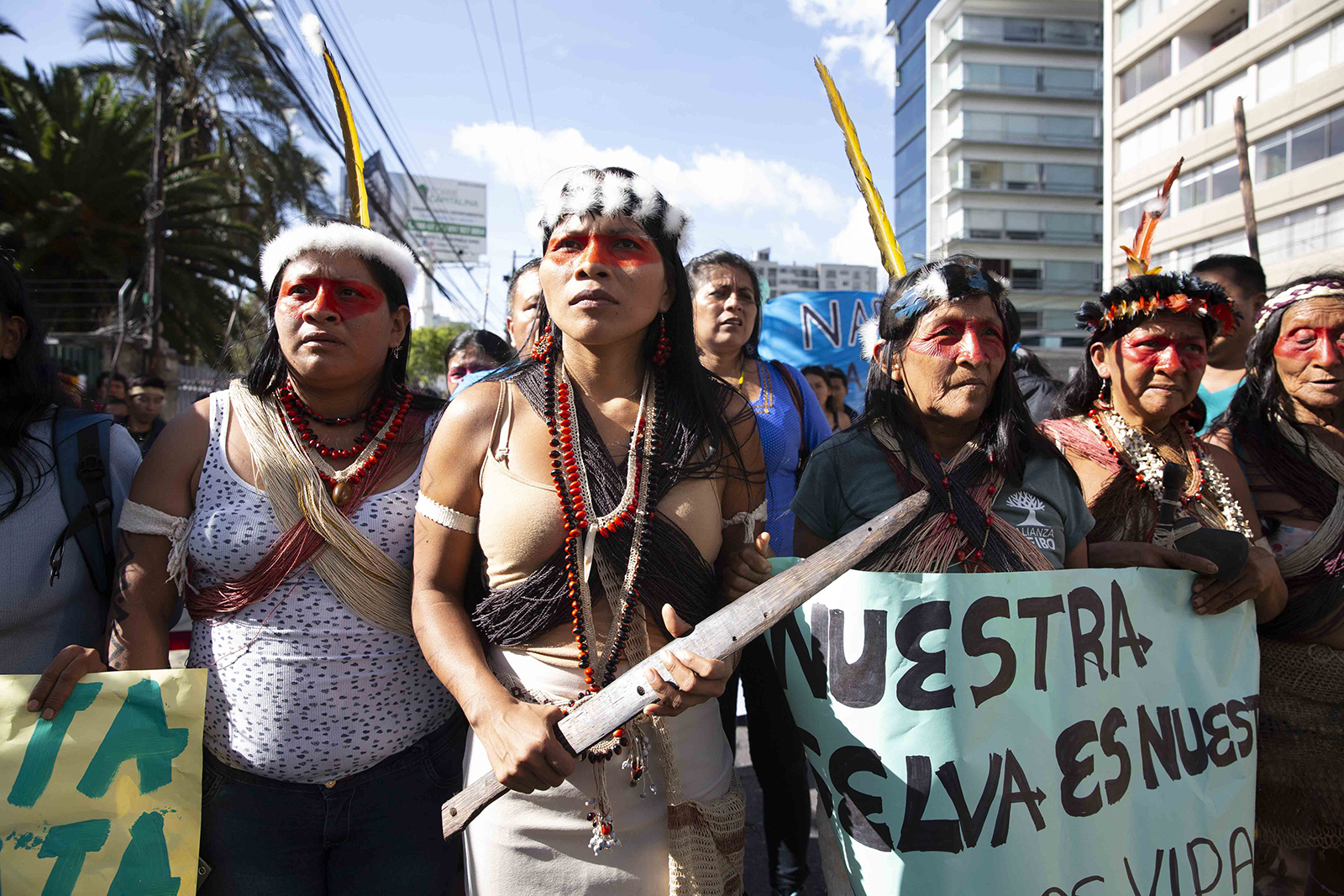
Nor should we fall into the trap of concluding that because women are not on the fore, they are not involved or are complacent. Women are key actors in Indigenous social justice and environmental struggles (Jenkins 2015), such as climate change. Feminist approaches to climate change are often holistic, systemic movements that address multiple environmental and justice issues at the same time (Rodriguez Acha, 2017). Further, women who are denied public tribune engage in powerful “everyday resistance” (Scott, 1985; Zanotti, 2013). Laura Zanotti (2013), in a study entitled “Resistance and the politics of negotiation: women, place and space among the Kayapó in Amazonia, Brazil” found that the everyday events and decision making processes that most villagers engage in can be as important to resistance movements as the highly visible, public acts that only a few leaders of the community participate in. Finally, western ideas of individualism, and even a feminist emphasis on autonomy and leadership, can obscure the ways in which indigenous women exert influence in their communities for the good of the collective, rather than angling for individual women’s rights (Figueroa Romero, 2018).
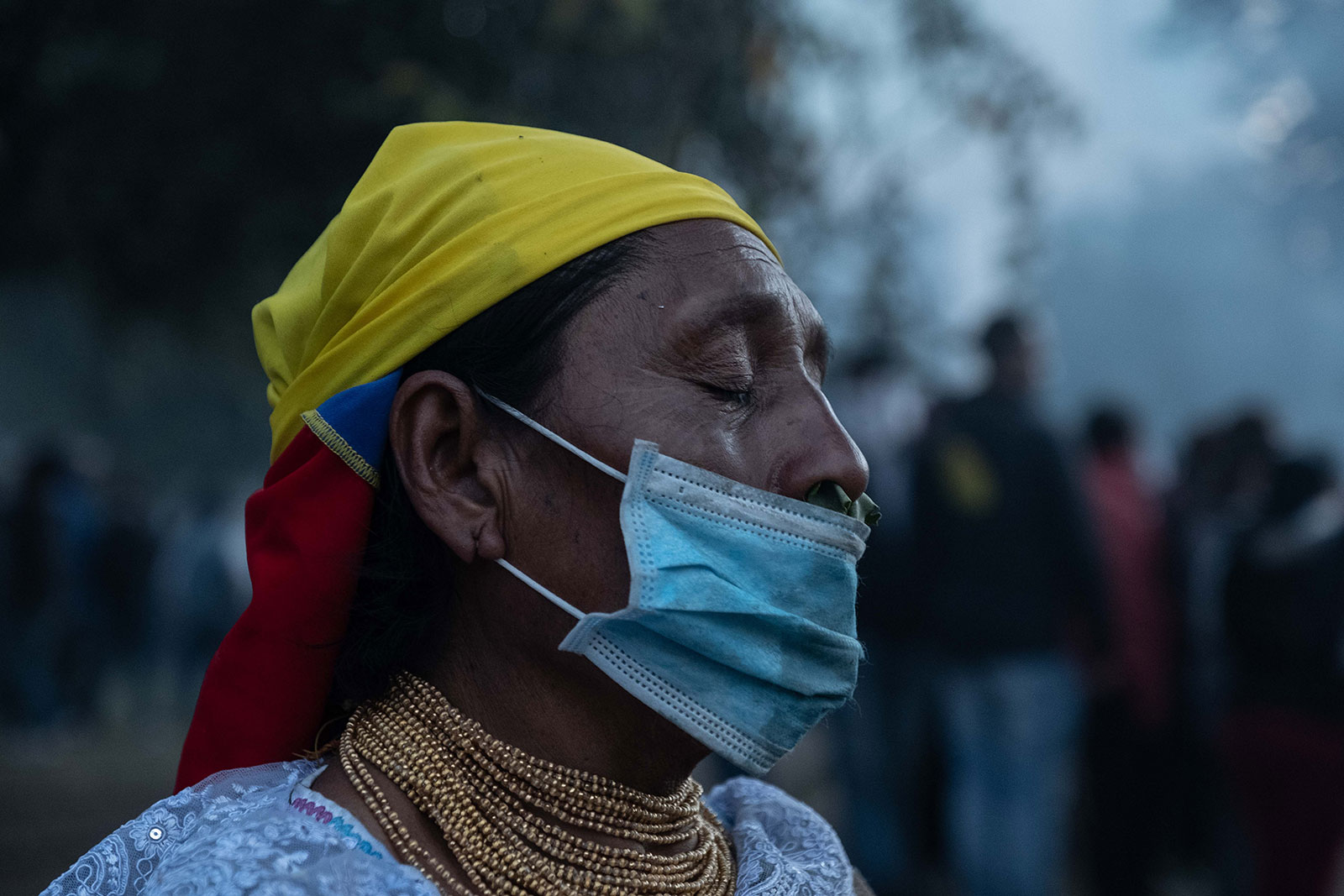
Tear gas, a chemical weapon, was the Ecuadorian police and military’s primary method to disperse crowds during the nationwide indigenous-led protests in October 2019
This gap between what is and what is seen exists across cultures and domains and it is also present in sectors such as sustainable forestry management (Elias et al. 2017) and health research. Karen Messing, a trailblazer of gender studies in occupational health, a field that largely considered women’s work as “light” and therefore without risk, wrote a book entitled “One-eyed Science” (1998) in which she lays bare the untold stories of women’s suffering at work and the structural issues that blind us to their suffering. More recently, Caroline Criado Perez (2019) exposes the gender data gap and reveals an invisible bias toward the male body. Her book is a startling litany of examples in which using “male” as default harms women: diagnosis of heart attacks, protective gear, and male-biased disaster warning systems. She calls this “male-unless-otherwise-indicated thinking.”
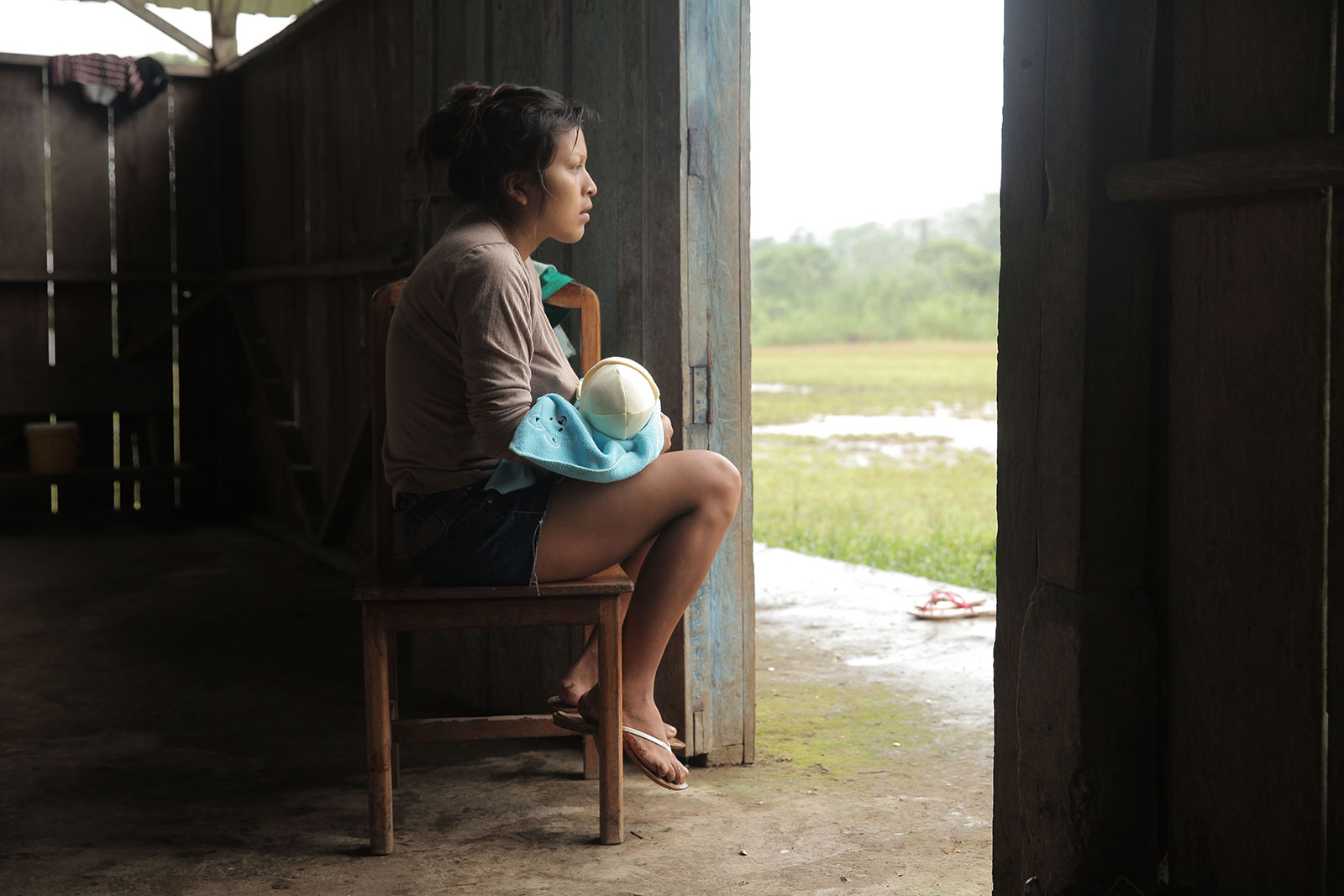
Indigenous woman caring for her child at home
Numerous scholars and movements have also pointed out that women’s labor is widely unrecognized. They draw attention to women’s invisible role in housework, as caretaker, as food provider. To cite an Amazonian example, Susanna Hecht (2007) noted that in the Amazonian Rubber Boom context “the quotidian presence of toiling women in households was viewed as unremarkable, and so remained unremarked.” (p.324)
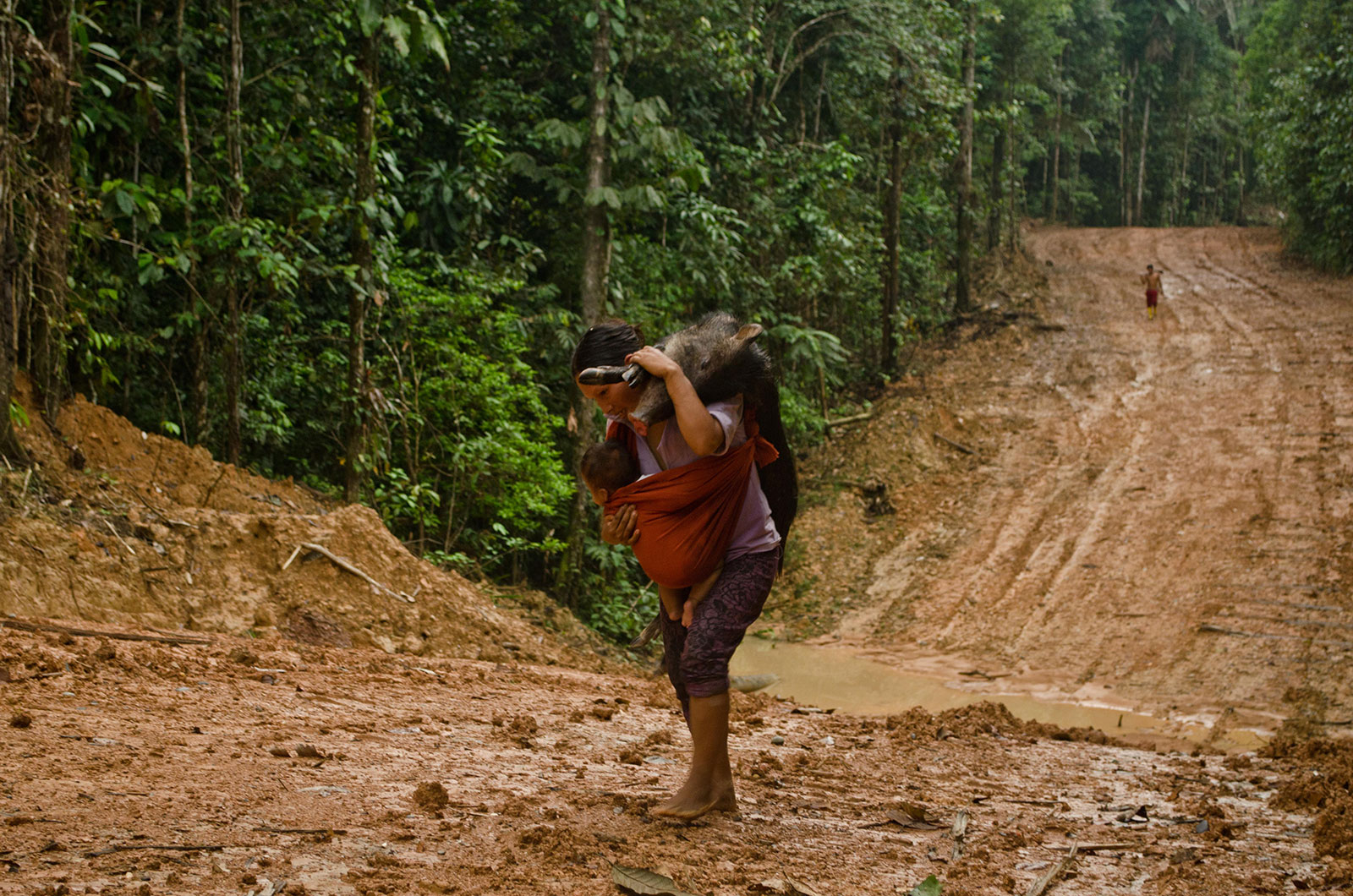
Women’s work is not “light” and is often repetitive, creating unique strain on the body. Here a Waorani woman carries her child and a wild boar back to the community, Yasuní National Park, Ecuadorian Amazon. Oil activity and the construction of oil roads have been severely detrimental to Waorani lands in the area
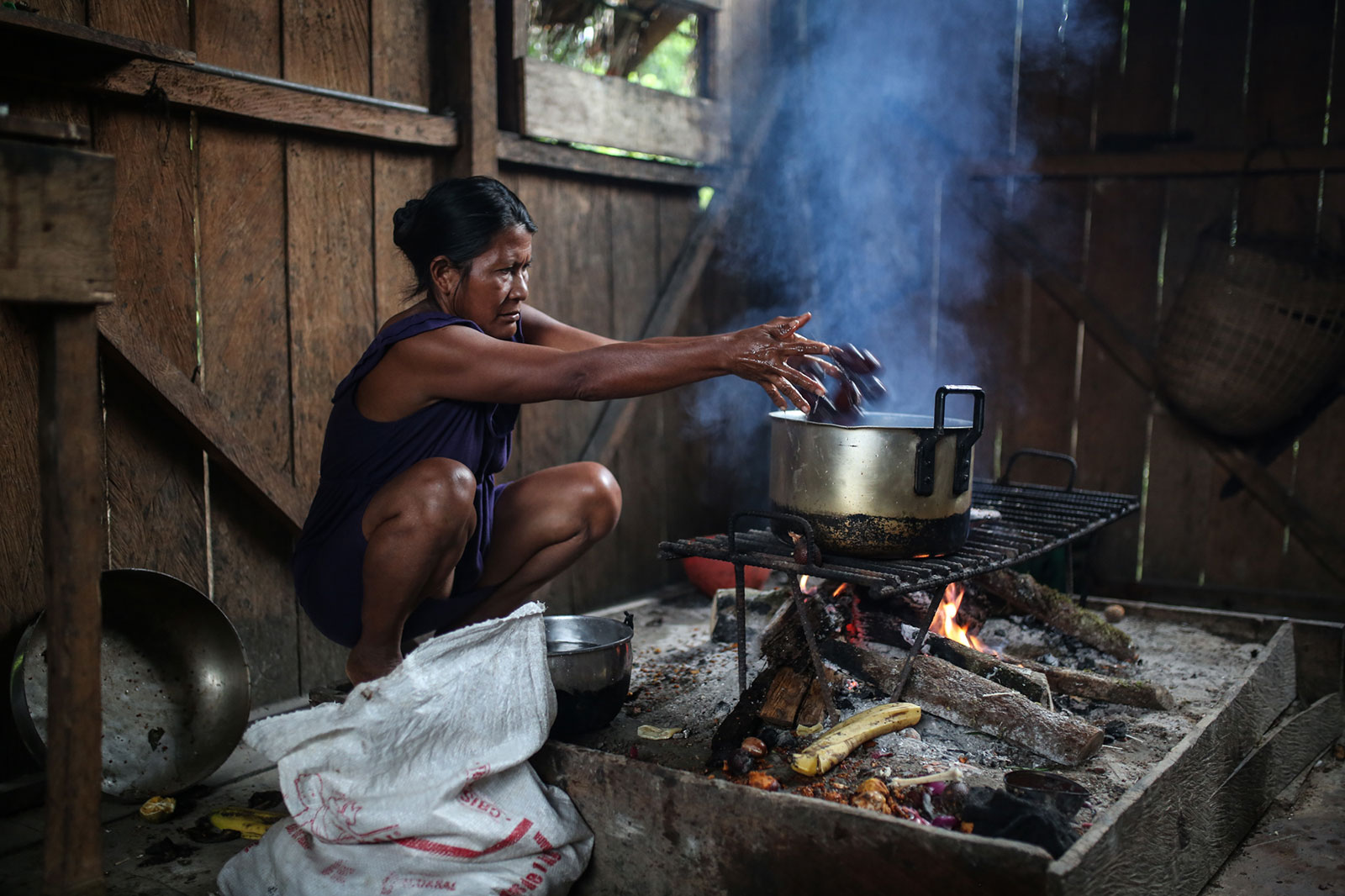
A Waorani woman prepares food in her home in the community of Nemonpare, Pastaza Province, Ecuadorian Amazon
The powerful ‘#metoo’ movement has exposed the pervasiveness of violence against women. Violence most often occurs in private spaces – homes, hotel rooms, dark alleyways – out of view. The fear of reprisal and shame prevents women from calling out their aggressors, perpetuating a cycle of voluntary blindness on the part of some and fearful silence on the part of others. Research by the World Health Organization shows that the lifetime prevalence of violence against women in rural Peru is 61% (WHO, 2005). In the Ecuadorian Amazon, researcher Isabel Goicolea (2001) found that the single most commonly cited women’s health problem was ‘husband beats wife,’ cited by 84% of respondents.
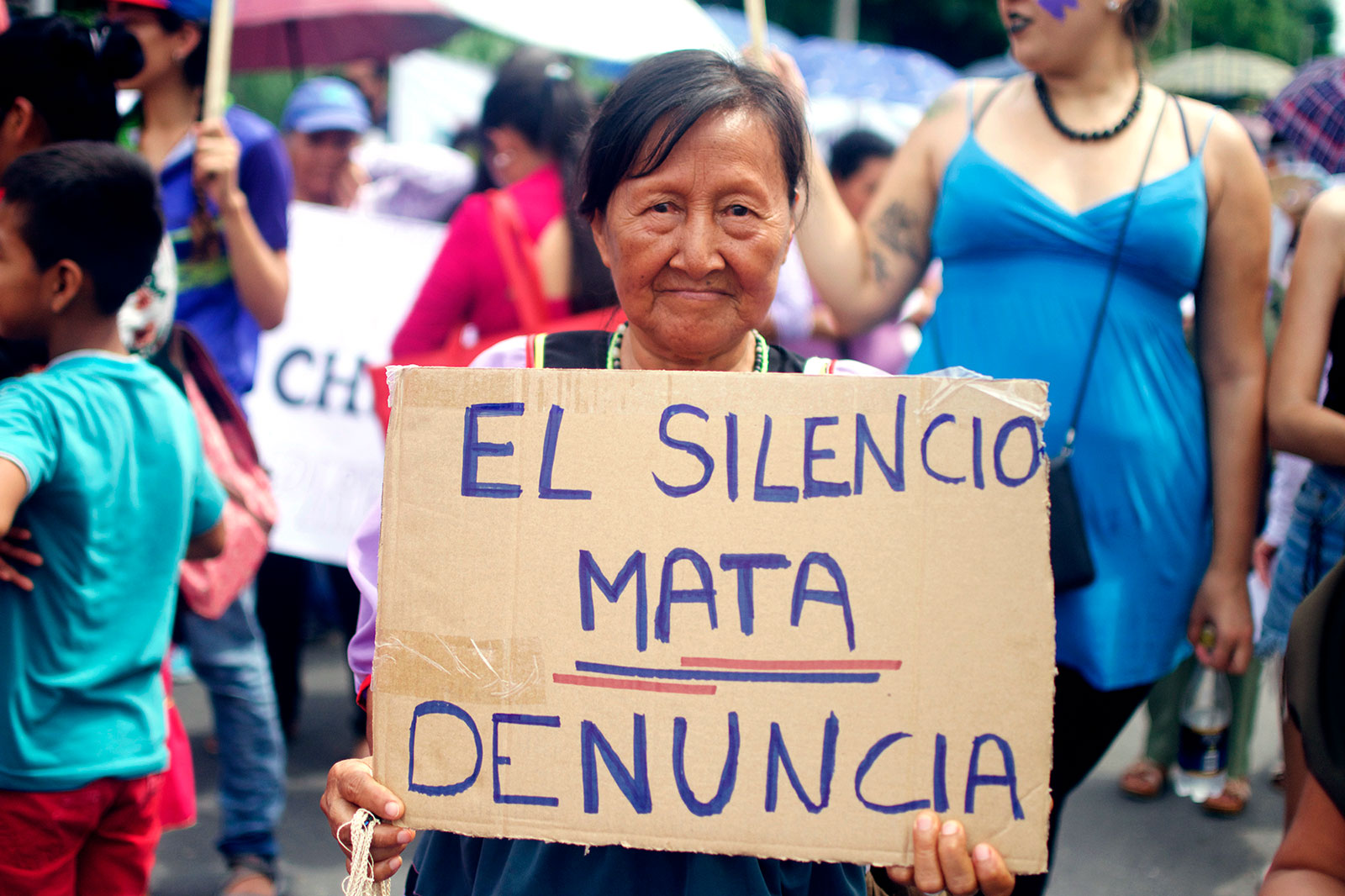
An indigenous woman holds a sign with the message “Silence kills – Denounce” during a protest on International Day for the Elimination of Violence against Women in 2018, Sucumbios Province, Ecuadorian Amazon
Ecosystems’ invisibility
The corollaries between women’s invisibility and ecosystems’ invisibility are striking. Ecosystems do not have representatives in governments or advocates on boards of directors. Their streams burble and the wind rustles through their leaves all over the world, but there is a generalized hush about them in parliaments and board rooms in those very same places. Ecosystems are largely absent from public discourse, planning, and decision making. When and where the environment is present, it is mostly viewed as a natural resource to be exploited in production processes, not as an entity with inherent value.
In this sense, women and ecosystems can also be perversely conspicuous in the some of the same ways. While women’s bodies are objectified, landscapes are eyed for their resources. While women are prized for their reproductive services, ecosystems are valued when they are ‘productive.’
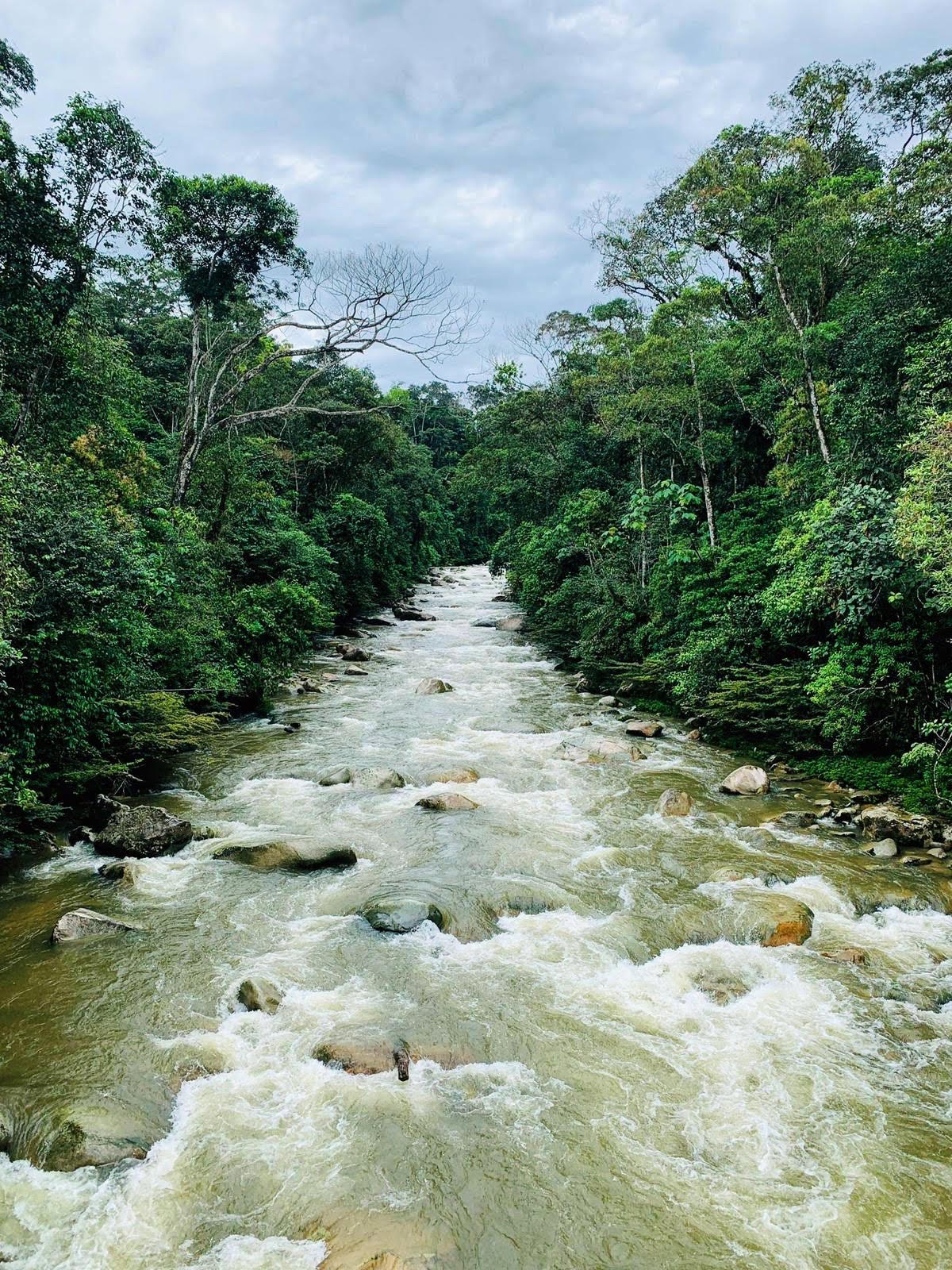
The Piatua River is one of the most beautiful rivers of the Ecuadorian Amazon. Earlier this year, the Kichwa people of Santa Clara won an important legal victory protecting the river from the construction of a hydroelectric dam, which threatened not only the river but also the Kichwa people’s way of life. Photo Courtesy Helena Gualinga
In some few instances and localities, people and systems are seeking ways in which the earth’s voice can be heard. For example, in 2008, Ecuador was the first country to enshrine the “rights of nature” in the constitution. Bolivia soon followed suit and since several countries, including New Zealand, Australia and India, have given legal rights to specific rivers (O’Donnell and Talbot-Jones, 2018). For years, the Ecuadorian edict remained quiet, until a series of court cases, including one brought to trial by the community of Sinangoe in 2018 against illegal mining, “activated” it. Nonetheless, Environmental Impact Assessments – the tool used by governments to evaluate the impacts of development projects on the health of the ecosystem – are too often done hastily, willfully turning a blind eye to the very factors that might impede the project.

Kofan leader Alexandra Narvaez from the community of Sinangoe in the Ecuadorian Amazon
Parallels also exist in the invisibility of the work that women and ecosystems carry out. Ecosystem ‘work’ is sometimes referred to as ecosystem services or the “subsidy of nature.” The Millennium Ecosystem Assessment (2005) shone a light on these services, giving them names and classifying them as provisioning services (e.g. food), regulating services (e.g. wastewater treatment), supporting services (e.g. habitat) and cultural services (e.g. mental health). Similar to women in their households, ecosystems “toil” to provide us with clean water, food, fertile soils, and materials, while this work remains patently “unremarked.” Seeing the hidden services of nature is essential for developing best practices and effective resource policies that protect ecosystems and the services they provide (Raudsepp-Hearne et al. 2010).
Lindsay Ofrias (2017), argues that the widespread contamination of the Ecuadorian Amazon by oil is an ‘invisible harm’ in that the violence that it represents is unseen even though the actual contamination is often very obvious. She also contends that this ‘invisible harm’ leads to ‘invisible opportunities’ to companies in the form of cost-cutting and even, contentiously, silencing opponents through their oppression. This ‘invisible opportunity’ has its equivalent in the gender sphere in that as women are silenced, men and their voices can benefit. Similarly, in a piece about the process of First Nations-Settler reconciliation in Canada, Hiba Zafran notes that reflexive attention to which discourses are used to frame concerns is central, as certain languages and ways of seeing “…render[…] invisible, [and do] not provide a language for the mixed intentionalities of oppressors, and possibilities within oppressive systems.” (Zafran, 2019).
The “Not in my backyard” (NIMBY) syndrome is an expression of the religation of environmental violence to out-of-the-way places, whereby toxic waste sites and open pit mines are exceedingly more likely to be located in poorer neighbourhoods and communities. The #NoDAPL (Dakota Access Pipeline) movement was precisely about a push to eclipse the potential damage of a pipeline by moving its original path from the white-dominated town, Bismark, to the Indigenous reserve, Standing Rock (Estes, 2017). Similarly, Maurice et al. (2019) recently documented local people’s testimony of oil companies using antiquated and now-illegal disposal practices that release wastes directly into the Ecuadorian Amazonian environment, clandestinely under the cover of night.

Siona leader Flor Tangoy shows oil contamination in the forest in the northern Ecuadorian Amazon
At the interface of women’s and ecosystems’ invisibility
Many contaminants inflicting violence on the environment literally are invisible: mercury, lead, PCBs, endocrine disruptors, all cannot be seen with the naked eye. As Michelle Murphy so aptly puts it, “…the infrastructure of chemical relations that surround and make us largely resides in the realm of the imperceptible (Murphy 2006). We might feel some of our chemical relations and the pain they cause, but the fullness of our chemical relations ends up being largely conjectural” (Murphy, 2017, p. 496). She later makes the point that, in this post-industrial era, these contaminants are also ubiquitous (Ibid, p. 497).
Donna Mergler (2012), a Canadian researcher with 50 years of experience investigating toxic hazards, makes the case that different exposure to contaminants for women and men can be obscured if data is not disaggregated along gender lines, while differential impacts can be occluded if data is not analyzed separately by sex. For example, women in the Amazon were found to be exposed to mercury (Webb et al., 2016) and hydrocarbons (Webb et al., 2017) through their relationship with water, whereas other factors were considered more important in exposure for men. If the data had not been explored separately for women and men this relationship would never have been uncovered.
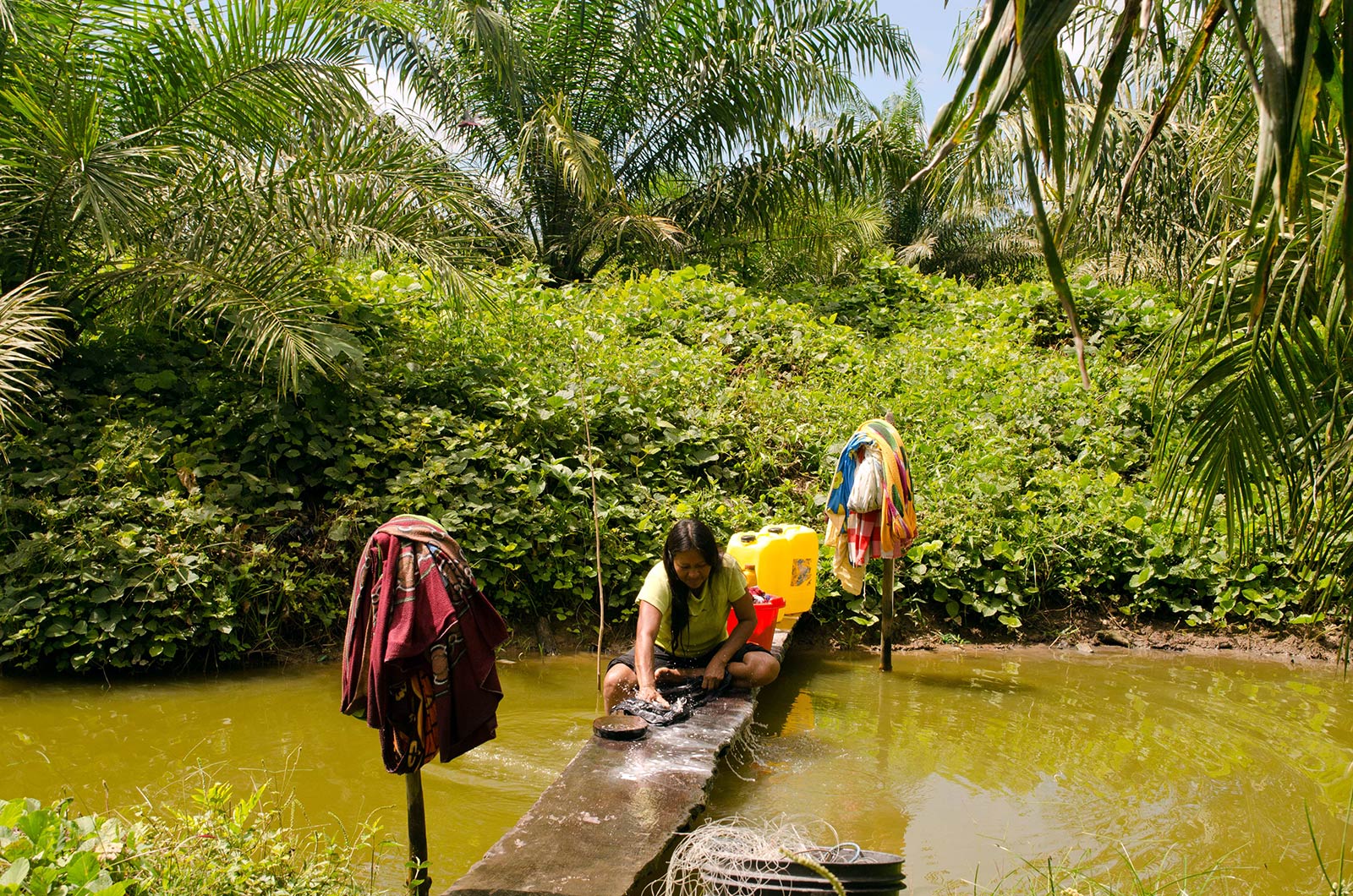
Research found that women’s use of water – washing clothes and dishes, bathing children and cooking – put them in contact with toxic chemicals from the petroleum industry. These aquatic environments are subject to additional sources of contamination such as pesticide run-off from palm oil monocultures
Conclusion
These multiple layers of invisibility – gender, ecosystem, race and contaminant – add up to create a virtual opaqueness in which the complexity and nuances involved seem too daunting to disentangle and depict. This parallel of invisibility is no coincidence. As Sharlene Mollett and Caroline Faria (2013) point out, “Gender and race are a historically important coupling that shapes and is shaped by space. Take the “myth of virgin land” in former “colonies” where women, and land are posited in the colonial texts to be “discovered”, “named” and “owned” and where indigenous peoples are made invisible by male conquers.”
Pulling back the invisibility cloak shrouding women and ecosystems exposes the roots of some of the more symptomatic, societal ills. Admitting that there is a gender imbalance in negotiating tables, editorial boards, high stakes meetings, parlaments, top executives, panels, health data, and so much more is a first step to redressing this inequality. Recognizing and embracing women’s and nature’s perspectives could lead to major paradigm shifts, such as more collaborative decision making processes and laws that are conceived, built and applied with a view to conserving ecosystem health into the future.
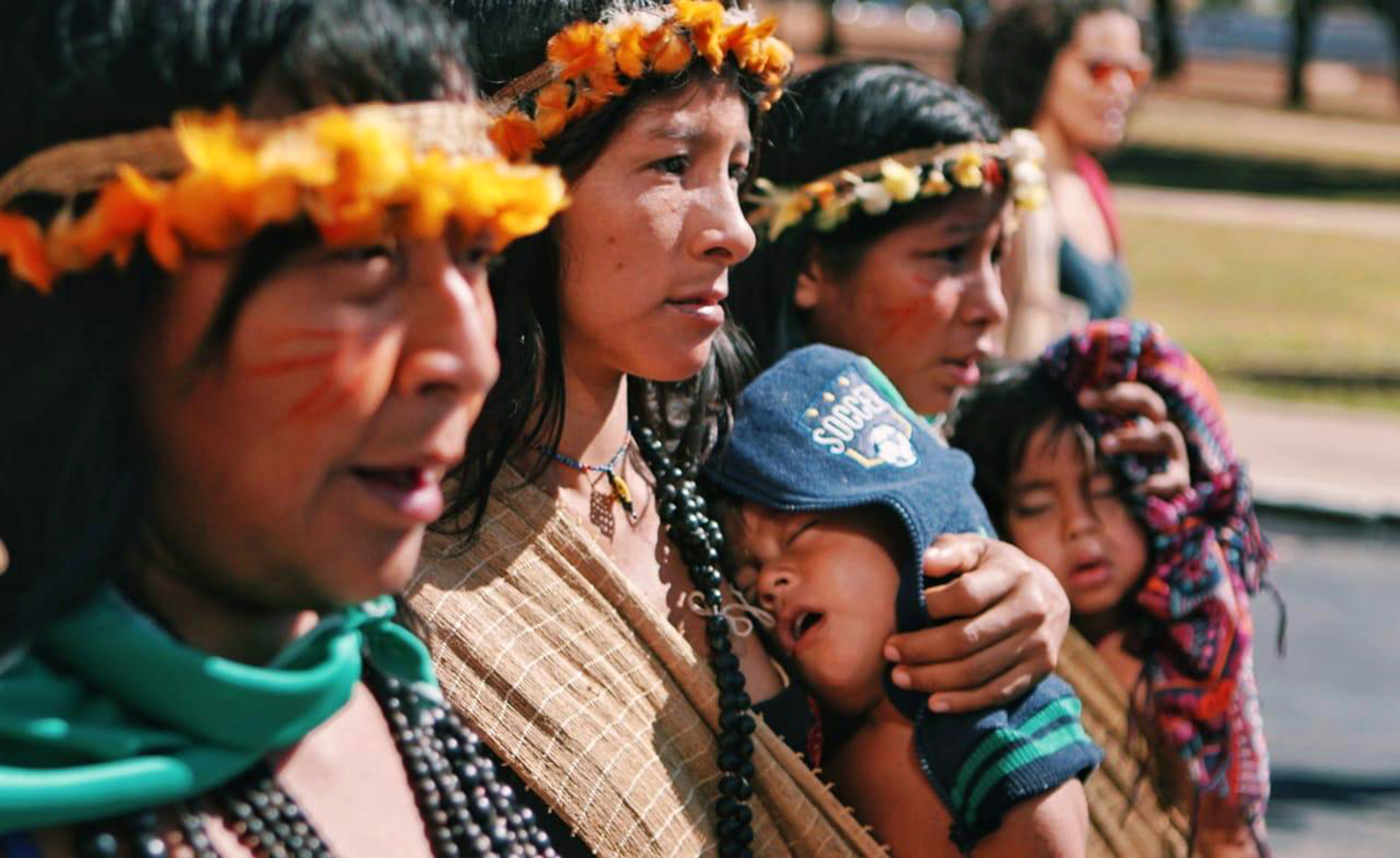
Brazilian Indigenous women marched on Congress in Brasilia to denounce escalating rights violations’, violence and invasions on their territories. Photo: Hivos
While we should be wary of “pinkwashing,” we should celebrate the courage of women who break through structural barriers to project their voice. Women’s marches and coalitions, such as the one in August 2019 in Brazil, are so important in rendering the work and perspectives of women in the Amazon visible. It is not because the system is biased against heeding women and incorporating them into official decision making processes that they are not there carrying out crucial work in the struggle against injustice. The 2019 upheaval in Ecuador sparked by International Monetary Fund (IMF) imposed austerity measures is perhaps an illustration of a society in transition. Indigenous women were at the forefront of the protests on the streets, as many emblematic images made clear, however, when it finally came time to negotiate with the government they were conspicuously underrepresented. Interestingly, while the protests were triggered by economic factors, they quickly became about much more as Indigenous peoples began to pronounce on their territorial rights.
Let this be a rallying cry to each of us to recognize where gender enters into our lives and work and to name it. We, as a society – meaning both men and women – need to look for opportunities to amplify women’s voices, from youth to elders, multiplying the occasions for women to lead, express themselves and take action.
References
- Brough, A. R., J. E. B. Wilkie, J. Ma, M. S. Isaac and D. Gal (2016). “Is Eco-Friendly Unmanly? The Green-Feminine Stereotype and Its Effect on Sustainable Consumption.” Journal of Consumer Research 43(4): 567-582
- Criado Perez, C. (2019). Invisible Women: Data Bias in a World Designed for Men, Harry N. Abram.
- Elias, M., R. Jalonen, M. Fernandez and A. Grosse (2017). “Gender-responsive participatory research for social learning and sustainable forest management.” Forests, Trees and Livelihoods 26(1): 1-12.
- Estes, N. (2017). “Fighting for our lives: #NoDAPL in Historical Context.” Wicazo Sa Review, 32(2), 115.
- Figueroa Romero, D. (2018). “Mujeres Indígenas del Ecuador: la larga marcha por el empoderamiento y la formación de liderazgos.” Canadian Journal of Latin American and Caribbean Studies / Revue canadienne des études latino-américaines et caraïbes 43(2): 253-276.
- Goicolea, I. (2001). “Exploring women’s needs in an Amazon region of Ecuador.” Reproductive Health Matters 9(17): 193-202.
- Hecht, S. B. (2007). “Factories, Forests, Fields and Family: Gender and Neoliberalism in Extractive Reserves.” Journal of Agrarian Change 7(3): 316-347.
- Jenkins, K. (2015). “Unearthing women’s anti-mining activism in the Andes: Pachamama and the “Mad Old Women”.” Antipode 47(2): 442-460.
- Maurice, L., F. López, S. Becerra, H. Jamhoury, K. Le Menach, M.-H. Dévier, H. Budzinski, J. Prunier, G. Juteau-Martineau, V. Ochoa-Herrera, D. Quiroga and E. Schreck (2019). “Drinking water quality in areas impacted by oil activities in Ecuador: Associated health risks and social perception of human exposure.” Science of The Total Environment 690: 1203-1217.
- Mergler, D. (2012). “Neurotoxic exposures and effects: Gender and sex matter! Hänninen Lecture 2011.” NeuroToxicology 33(4): 644-651.
- Messing, K. (1998). One-eyed Science: Occupational Health and Women Workers, Temple University Press.
- Millennium Ecosystem Assessment. (2005). Ecosystems and human well-being: synthesis. Washington, DC.
- Mollett, S. and C. Faria (2013). “Messing with gender in feminist political ecology.” Geoforum 45: 116-125.
- Murphy, M. (2006). Sick Building Syndrome and the Problem of Uncertainty: Environmental Politics, Technoscience, and Women Workers. Durham, N.C., Duke University Press.
- Murphy, Michelle. 2017. “Alterlife and Decolonial Chemical Relations.” Cultural Anthropology 32(4): 494-503. https://doi.org/10.14506/ca32.4.02.
- O’Donnell, E. L. and J. Talbot-Jones (2018). “Creating legal rights for rivers: lessons from Australia, New Zealand, and India.” Ecology and Society 23(1).
- Ofrias, L. (2017). “Invisible harms, invisible profits: a theory of the incentive to contaminate.” Culture, Theory and Critique 58(4): 435-456.
- Raudsepp-Hearne, C., G. D. Peterson and E. M. Bennett (2010). “Ecosystem service bundles for analyzing tradeoffs in diverse landscapes.” Proceedings of the National Academy of Sciences 107(11): 5242-5247.
- Rodriguez Acha, M. A. (2017). “We have to wake up, humankind! Women’s struggles for survival and climate and environmental justice.” Development 60(1-2)((1-2)): 32-39.
- Scott, J. (1985). Weapons of the weak: Everyday forms of peasant resistance. New Haven, CT, Yale University Press.
- Webb, J., O. T. Coomes, D. Mergler and N. Ross (2016). “Mercury Concentrations in Urine of Amerindian Populations Near Oil Fields in the Peruvian and Ecuadorian Amazon.” Environmental Research 151: 344-350.
- Webb, J., O. T. Coomes, D. Mergler and N. A. Ross (2017). “Levels of 1-hydroxypyrene in urine of people living in an oil producing region of the Andean Amazon (Ecuador and Peru).” International Archives of Occupational and Environmental Health 91(1): 105-115.
- WHO (World Health Organization) (2005). WHO multi-country study on women’s health and domestic violence against women: summary report of initial results on prevalence, health outcomes and women’s responses. Geneva, World Health Organization.
- Zafran, H. (2019). Ecopoetics and unbelonging: Shaping ground within Indigenous partnerships. [Workshop presentation]. Paper presented at the Advanced Study Institute in Cultural Psychiatry: Cultural Poetics of Illness and Healing: Embodiment, Enactment and the Politics of Experience, Montréal, QC
- Zanotti, L. (2013). “Resistance and the politics of negotiation: women, place and space among the Kayapó in Amazonia, Brazil.” Gender, Place & Culture 20(3): 346-362.




